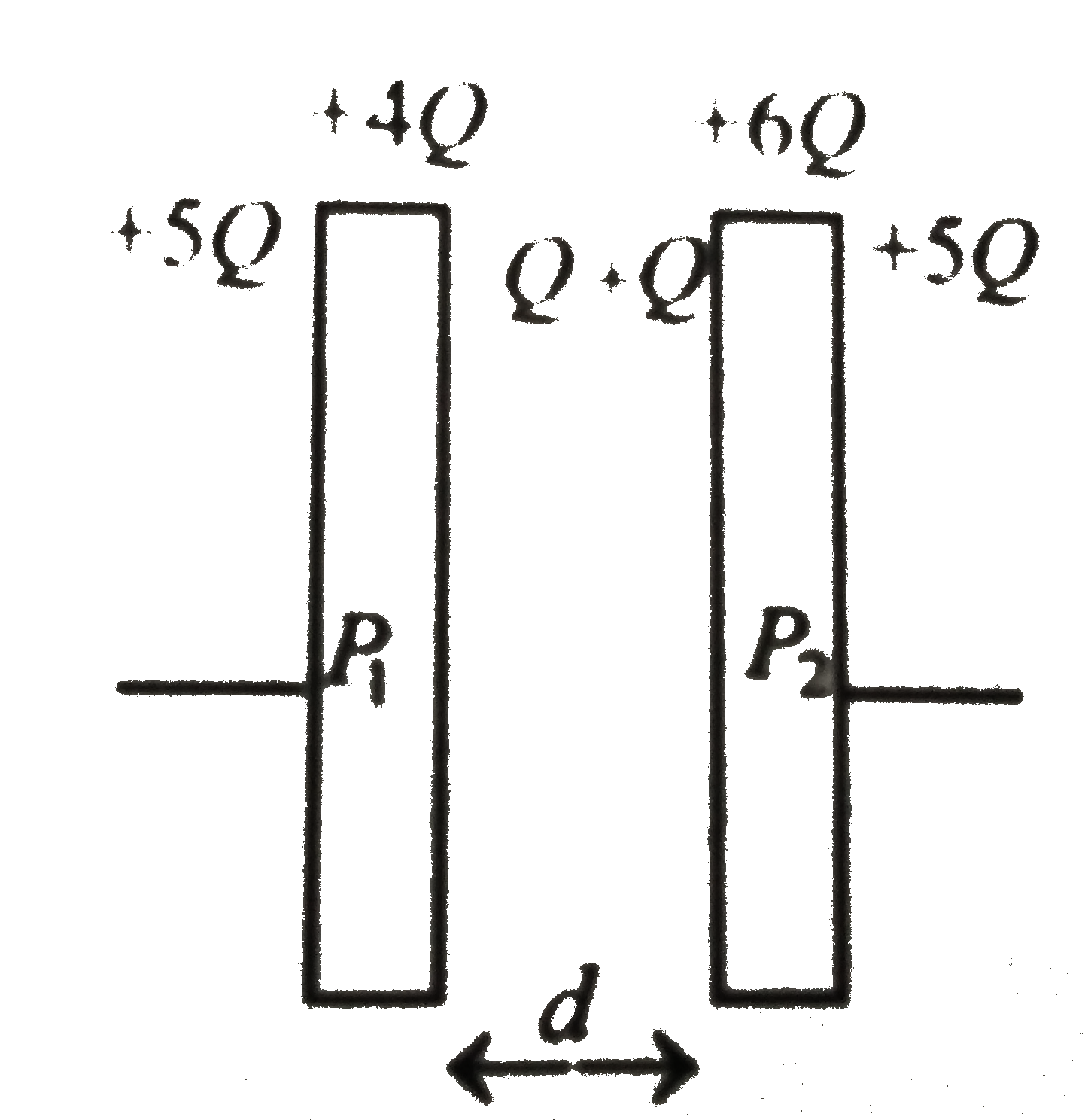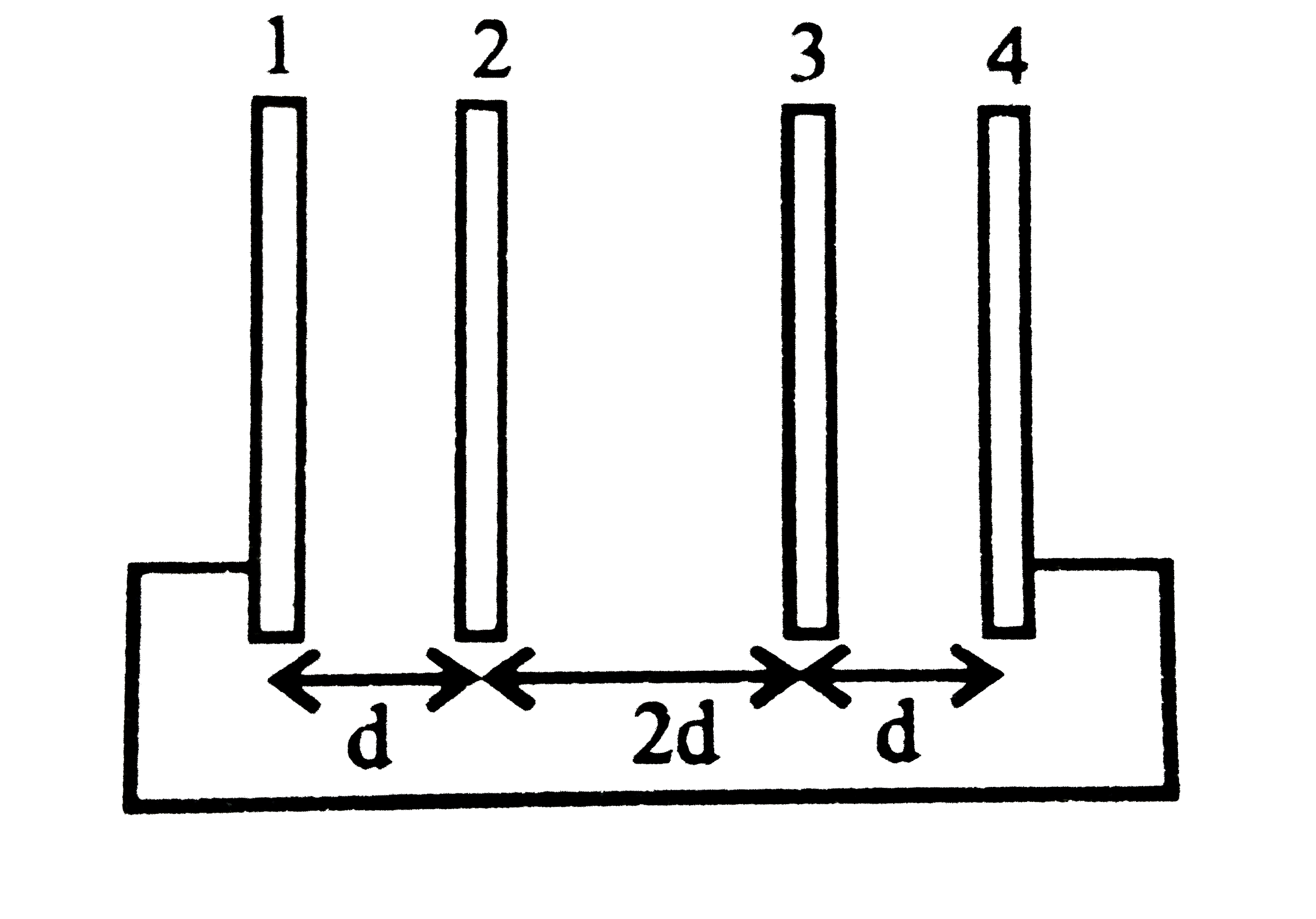Two identical conducting very large plates P1andP2 having charges +4Qand+6Q are placed very closed to each other at separation d. The plate area of either face of the plate is A. The potential difference between plates P1andP2 is

VP1−VP2=QdAε0
VP1−VP2=−QdAε0
VP1−VP2=5QdAε0
VP1−VP2=−5QdAε0
The correct Answer is:B
b. Potential difference between the plates is

VP1−VP2=−Q(ε0A/d)=−Qdε0A
Topper's Solved these Questions
- MISCELLANEOUS VOLUME 3BOOK - CENGAGE PHYSICSCHAPTER - MISCELLANEOUS VOLUME 3EXERCISE - Multiple Correct Answer type
109 Videos
- MISCELLANEOUS VOLUME 3BOOK - CENGAGE PHYSICSCHAPTER - MISCELLANEOUS VOLUME 3EXERCISE - Assertion and Reason Type
8 Videos
- MECHANICAL PROPERTIES OF SOLIDSBOOK - CENGAGE PHYSICSCHAPTER - MECHANICAL PROPERTIES OF SOLIDSEXERCISE - Question Bank
4 Videos
- MISCELLANEOUS VOLUME 5BOOK - CENGAGE PHYSICSCHAPTER - MISCELLANEOUS VOLUME 5EXERCISE - Integer
12 Videos
Similar Questions
Four parallel large plates separated by equal distance d are arranged as shown in. The area of the plates is S Find the potential differnce between plats BandC if plate B is given a charge Q.
 .
.
View SolutionTwo identical metal plates each having surface area A, having charges q1andq2, are placed facing each other at a separation d. Find the charge appearing on
surface (1),(2),(3), and (4). Assume the size of the plate is much larger than the separation between the plates.
View Solution
Knowledge Check
Two identies conducting very large plates P1 and P2 having charges +4Q and +6Q are placed very closed to each other at separation d .The plate area of either face of the plate is A.the potential difference between plates P1 and P2 is
 AVP1−VP2=QdAε0BVP1−VP2=−QdAε0CVP1−VP2=5QdAε0DVP1−VP2=−5QdAε0
AVP1−VP2=QdAε0BVP1−VP2=−QdAε0CVP1−VP2=5QdAε0DVP1−VP2=−5QdAε0Two conducting large plates P1&P2 are placed parallel to each other at very small seperation 'd'. The plate area of either face of plate is A. A charge +2Q is given to plate P1 & -Q to the plate P2 (neglect ends effects). If plate P1&P2 are now connected by conducting wire, then total amount of heat produced is
 A4Q2d3∈0AB9Q2d8∈0AC3Q2d8∈0ADNone of these
A4Q2d3∈0AB9Q2d8∈0AC3Q2d8∈0ADNone of theseIn an isolated parallel plate capacitor of capacitance C, the plates have charge Q1 and Q2. The potential difference between the plates is
AQ1+Q22CBQ1−Q22CCQ12CD−Q22C
Charges 2q and −3q are given to two identical metal plates of area of cross section A. the distance between the plates is d. Find the capacitance and potential difference between the plates.

View SolutionFind the charge on each plate given area of each plate is A and separation between two consecutive plates is d.

View SolutionFour metallic plates are placed as shown in the figure .Plate 2 is given a cgharge Q whereas all other plates are uncharged . Plates 1 and are joined together . The area of each plate is same .
 .
.
The potential difference beetween plates 1 and 2 is -
View SolutionTwo identical metal plates are given poistive charges Q1 and Q2 (<Q1) respectively. If they are now brought close together to form a parallel plate capacitor with capacitance C, the potencial difference between them is
View SolutionTwo parallel metal plates having charges +Q and −Q face each other at a certain distance between them.If the plates are now dipped in kerosene oil tank ,the electric field between the plates will
View Solution
